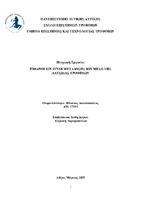| dc.contributor.advisor | Λαμπροπούλου, Κυριακή | |
| dc.contributor.author | Διονυσόπουλος, Φίλιππος | |
| dc.date.accessioned | 2023-04-05T10:27:02Z | |
| dc.date.available | 2023-04-05T10:27:02Z | |
| dc.date.issued | 2023-03 | |
| dc.identifier.uri | https://polynoe.lib.uniwa.gr/xmlui/handle/11400/4180 | |
| dc.identifier.uri | http://dx.doi.org/10.26265/polynoe-4019 | |
| dc.description.abstract | Το θέμα της πτυχιακής αυτής εργασίας αφορά τους τρόπους μετάδοσης των ιών μέσω της αλυσίδας τροφίμων καθώς και τους πιθανούς κινδύνους που προκύπτουν από τη μετάδοση. Αρχικά παρουσιάζονται γενικές πληροφορίες για τους ιούς σχετικά με τη δομή και τη λειτουργεία τους. Μετά γίνεται αναφορά στους κυριότερους ιούς που συναντιούνται στα τρόφιμα και παρέχονται πληροφορίες για τα γενικά χαρακτηριστικά τους. Η πτυχιακή συνεχίζει αναλύοντας την μετάδοση των ιών στην αλυσίδα τροφίμων. Συγκεκριμένα παρουσιάζονται λεπτομερώς οι λόγοι για τους οποίους είναι εφικτή η μετάδοση, οι διάφοροι οδοί που ακολουθούν οι ιοί για να φτάσουν σε προϊόντα της αλυσίδας τροφίμων που προορίζονται για κατανάλωση καθώς και τα τρόφιμα για τα οποία υφίσταται η μεγαλύτερη πιθανότητα να μολύνουν τον ανθρώπινο πληθυσμό με ιούς και να προκληθεί μέσω αυτών λοίμωξη. Ύστερα παρέχονται πληροφορίες σχετικά με τον κίνδυνο που εγκυμονεί η μετάδοση των τροφιμογενών ιών και η μόλυνση από αυτούς. Δηλαδή αναφέρονται τα συμπτώματα που προκαλούνται από τροφιμογενη νόσο ιικής προέλευσης αλλά και η έκταση που μπορεί να λάβει μία έξαρση τροφιμογενής λοίμωξης με επιδημιολογικά δεδομένα. Στη συνέχεια παρουσιάζονται οι σύγχρονοι τρόποι με τους οποίους πραγματοποιείται η ανίχνευση τροφιμογενών ιών κυρίως στα ίδια τα τρόφιμα. Μετά γίνεται περιληπτική αναφορά στην εκτίμηση κινδύνου που υφίσταται για τους τροφιμογενείς ιούς. Το κυρίως θέμα τελειώνει εστιάζοντας στους τρόπους με τους οποίους μπορεί να προληφθεί η μετάδοση και να ελεγχθεί ο κίνδυνος από τροφιμογενείς ιούς στη βιομηχανία. Σε αυτό το μέρος δίνεται ιδιαίτερη έμφαση στις μεθόδους επεξεργασίας των τροφίμων για απενεργοποίηση των ιών. Επίσης παρουσιάζονται και κατάλληλα μέτρα πριν από αυτή την επεξεργασία. Από όλα αυτά προκύπτει το συμπέρασμα ότι πρέπει να δοθεί μεγαλύτερη προσοχή από την επιστημονική κοινότητα στα τρόφιμα ως πιθανές πηγές ιικής μόλυνσης και περισσότερη έρευνα πάνω στη μετάδοση των ιών στην αλυσίδα τροφίμων. Επιπλέον χρειάζεται αναβάθμιση των μικροβιολογικών κριτηρίων για ασφαλή τρόφιμα και των τρόπων αντιμετώπισης της μετάδοσης των τροφιμογενών ιών. | el |
| dc.format.extent | 46 | el |
| dc.language.iso | el | el |
| dc.publisher | Πανεπιστήμιο Δυτικής Αττικής | el |
| dc.rights | Αναφορά Δημιουργού - Μη Εμπορική Χρήση - Παρόμοια Διανομή 4.0 Διεθνές | * |
| dc.rights | Attribution-NonCommercial-NoDerivatives 4.0 Διεθνές | * |
| dc.rights | Attribution-NonCommercial-NoDerivatives 4.0 Διεθνές | * |
| dc.rights | Attribution-NonCommercial-NoDerivatives 4.0 Διεθνές | * |
| dc.rights.uri | http://creativecommons.org/licenses/by-nc-nd/4.0/ | * |
| dc.subject | Νοροϊός | el |
| dc.subject | Ηπατίτιδα Α | el |
| dc.subject | Ηπατίτιδα Ε | el |
| dc.subject | Τροφιμογενείς ιοί | el |
| dc.title | Πιθανοί κίνδυνοι μετάδοσης ιών μέσω της αλυσίδας τροφίμων | el |
| dc.title.alternative | Potential hazards of virus transmission through the food chain | el |
| dc.type | Πτυχιακή εργασία | el |
| dc.contributor.committee | Τσάκαλη, Ευσταθία | |
| dc.contributor.committee | Κοντελές, Σπυρίδων | |
| dc.contributor.faculty | Σχολή Επιστημών Τροφίμων | el |
| dc.contributor.department | Τμήμα Επιστήμης και Τεχνολογίας Τροφίμων | el |
| dc.description.abstracttranslated | The topic of this thesis concerns the ways of transmission of viruses through the food chain as well as the possible risks that arise from transmission. First of all, general information about viruses is presented regarding their structure and function. Then, main viruses encountered in food are mentioned and information about their general characteristics is provided. The thesis continues by analyzing the transmission of viruses in the food chain. Specifically, there is a detailed presentation of the reasons which make transmission possible, the various routes that the viruses follow in order to reach products in the food chain intended for consumption as well as the foods with the highest chance of infecting the human population and causing infection. Later, information is provided regarding the dangers associated with the transmission of foodborne viruses and the infection from them. The symptoms caused by foodborne illness of filial origin are mentioned, but also the extent that a foodborne infection can take by providing epidemiological data. Then modern ways of detection of foodborne viruses, mainly in food itself, are presented. Later there is a summary of the risk assessment that exists for foodborne viruses. The main topic ends by focusing on the ways, that enable prevention of transmission of foodborne viruses in the industry and control the risk associated with them. In this part emphasis is given on food processing methods for inactivation of viruses. Appropriate measures prior to this processing are also presented. From all this, the conclusion is that the scientific community needs to give more consideration to food as a possible source of filial contamination and more research on the transmission of viruses in the food chain has to be conducted. In addition, microbiological criteria for safe food products and the ways to deal with the transmission of foodborne viruses have to be upgraded. | el |


